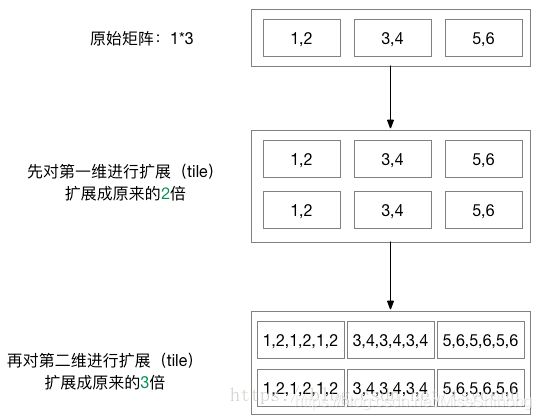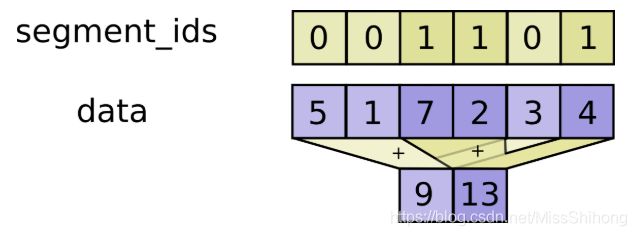tf.segment_sum()_ tf.while_loop()_ tf.clip_by_value()_ tf.tile()_ tf.unique_with_counts()
这几天 在阅读大项目LaneNet的损失函数计算部分时,遇到了许多未曾一见的tensorflow的函数,上网查找资料后做一个学习笔记。
分段求和 tf.segment_sum()
1.14之后将它移到了math模块下
tf.math.segment_sum(
data,
segment_ids,
name=None
)
- o u t p u t i = ∑ j d a t a j output_i = \sum_j data_j outputi=∑jdataj 其中,求和针对所有满足
segment_ids[j] == i的 j; - segment_ids的长度必须与data的第一维度相同。
- segment_ids的序列必须递增
- 类似的, tf还支持分段求mean, max, min等
tf.unsorted_segment_sum() 是改进版,segment_ids 无需有序递增,且可以不用覆盖所有的值。
tf.math.unsorted_segment_sum(
data,
segment_ids,
num_segments, # segment_ids的最大值需 < num_segments
name=None
)
关于这两个函数的实例可参考 https://www.cnblogs.com/gaofighting/p/9706081.html
按索引提取向量 tf.gather()
用一个一维的索引数组,提取张量中对应索引的向量
a = tf.Variable([[1,2,3,4,5], [6,7,8,9,10], [11,12,13,14,15]])
index_a = tf.Variable([0,2])
b = tf.Variable([1,2,3,4,5,6,7,8,9,10])
index_b = tf.Variable([2,4,6,8])
with tf.Session() as sess:
sess.run(tf.global_variables_initializer())
print(sess.run(tf.gather(a, index_a)))
# [[ 1 2 3 4 5]
# [11 12 13 14 15]]
print(sess.run(tf.gather(b, index_b)))
# [3 5 7 9]
封装过的while循环 tf.while_loop()
看到这个函数时被惊艳了 它的用法好酷
loop = []
while cond(loop):
loop = body(loop)
loop为每轮迭代需要更新的元素的集合列表,cond函数所判断的condition成立时,进入while循环,body函数对loop中的元素进行更新;当condition不满足,循环终止。
在定义时,cond和body函数必须接受一样的参数;loop返回bool,body必须返回输入的所有参数(更新后的)
来看LaneNet中计算loss时用到的while_loop()
def cond(label, batch, out_loss, out_var, out_dist, out_reg, i):
return tf.less(i, tf.shape(batch)[0])
def body(label, batch, out_loss, out_var, out_dist, out_reg, i):
disc_loss, l_var, l_dist, l_reg = discriminative_loss_single(
prediction[i], correct_label[i], feature_dim, image_shape, delta_v, delta_d, param_var, param_dist, param_reg)
out_loss = out_loss.write(i, disc_loss)
out_var = out_var.write(i, l_var)
out_dist = out_dist.write(i, l_dist)
out_reg = out_reg.write(i, l_reg)
return label, batch, out_loss, out_var, out_dist, out_reg, i + 1
# TensorArray is a data structure that support dynamic writing
output_ta_loss = tf.TensorArray(dtype=tf.float32, size=0, dynamic_size=True)
output_ta_var = tf.TensorArray(dtype=tf.float32, size=0, dynamic_size=True)
output_ta_dist = tf.TensorArray(dtype=tf.float32, size=0, dynamic_size=True)
output_ta_reg = tf.TensorArray(dtype=tf.float32, size=0, dynamic_size=True)
_, _, out_loss_op, out_var_op, out_dist_op, out_reg_op, _ = tf.while_loop(
cond, body, [correct_label, prediction, output_ta_loss, output_ta_var, output_ta_dist, output_ta_reg, 0])
数值截断 tf.clip_by_value()
tf.clip_by_value(
t,
clip_value_min,
clip_value_max,
name=None
)
- 参数clip_value_min 和 clip_value_max 可以是一组序列,这组序列可以是Tensor也可以是list,它长度必须与待截断序列相同。
- 因此可以用来表示 [ x ] + = m a x ( 0 , x ) [x]_+ = max(0, x) [x]+=max(0,x) 这种情况

张量扩展 tf.tile()
input是待扩展的张量,multiples是扩展方法。
假如input是一个3维的张量。那么mutiples就必须是一个1x3的1维张量。这个张量的三个值依次表示input的第1,第2,第3维数据扩展几倍。
tf.tile(
input,
multiples,
name=None
)
举例说明
a = tf.constant([[1, 2], [3, 4], [5, 6]], dtype=tf.float32)
a1 = tf.tile(a, [2, 3])

tf.unique_with_counts
# tensor 'x' is [1, 1, 2, 4, 4, 4, 7, 8, 8]
y, idx, count = unique_with_counts(x)
y ==> [1, 2, 4, 7, 8]
idx ==> [0, 0, 1, 2, 2, 2, 3, 4, 4]
count ==> [2, 1, 3, 1, 2]
按布尔值获取元素 tf.boolean_mask()
- Numpy equivalent is
tensor[mask]
tf.boolean_mask(
tensor,
mask,
axis=None,
name='boolean_mask'
)
# 2-D example
tensor = [[1, 2], [3, 4], [5, 6]]
mask = np.array([True, False, True])
boolean_mask(tensor, mask) # [[1, 2], [5, 6]]

